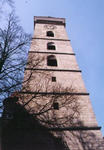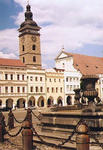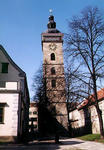
In the year 1547, the city council of Ceske Budejovice accepted the decision to build a tower to serve, apart from the representation of the city, as
a bell-and guard-tower. Probably the city council was inspired by other cities, especially Klatovy, where the tower was becoming popular.
In the same year stone quarrying began and two years later a foundation for a future tower was laid in the neighbourhood of the Saint Nicolas's church. The foundation was anchored by oak pilots because of subsurface water. The founding stone for the building was set on June 20,1550. Construction materials was transported through the doors at the eastern side of the tower, with the year 1552 inscribed at
the rectangular portal. The building was directed by master builder Hons until 1555, then by master builder Lorenc, and lastly until 1565 by Vincenc Vogarell, all Italians. The work of master Hons is the small round tower at the south-east corner with the spiral stairs, leading to the first floor. Above the entrance is shown the year: 1553.
Master Vogarell directed the building until its completion and was responsible for the tower's present appearance. From his predecessors he borrowed several architectural items, such as the delineation of individual floors with ledges and the slightly sloping walls. The top floor had twice the height of the three lower-floors. He also employed gothic spires around the windows on all four sides of the three floors, from which the sound of bells could be heard from outside. Two of the bells were placed in November 1573, when prisma of tower was finished. The bells were not new ones, but they were moved from the old belfry of the church.
The bell called Marta was cast in the year 1506 by Prague bell master Bartolomej. The second bell named Bumerin was from the workshop of local blacksmith and bell master Mikulas. In June 1576, an unknown artist painted several coat-of-arms at the top of the tower, and at the north and south sides were added reliefs of the city and Habsburgs coat-of-arms. In October 1576, a guard room was added to the tower and its gallery was completed with ballustrade from stone, divided at each side into 5 sections by Tuscon columns to support the roof. The roof was built by

carpenter Martin Khopff and was capped by three-part renaissance dome with lanterns. In May 1577, a local goldsmith decorated the dome with a little banner and with its installation was the construction completed.
The construction lasted 28 years. For his salary the communal teller was given 9,560 t hree-scores of groshes. Material, stone, lime and wood was brought from nearby forests and quarries.
The completed city tower was for its times a remarkable technical achievement, as is obvious from its dimensions. From the ceiling to the balcony is 48.80 m and the total height to the top is 71.90 m. The Base of the tower is a square with each side 11.60 m in lenght and the walls are 3.10 m thick. At each floor the walls slope slightly and thus at the top of the clock each of the four walls is smaller by 0.90 m and the thickness of walls is decreased by 1.96 m. At the time of its building it was common practice to orient the tower in a south-north direction, but during the past centuries there appeared a deviation by 17 degrees 30 minutes towards the west. There was also a deviation from the vertical axis, which was in 1917 about 36 centimeters.
Originally the tower clock was not intended. In 1606 watchmaker Donat from Trebon transmitted clock-machine which on the south and north sides showed time at 24-hours circle, and at west and east side in half, 12-hours circle. The dials were painted by the painter Bartolomej.
Beranek from Cesky Krumlov immediately after their instalation in the tower walls.The clock functioned until 1637, when it was substituted by a never one. Over the next centuries the tower clock was modified several times.
Neither of the bells are of their original design from the beginning of the 16
th Century. The larger one called Bumerin cracked and was re-cast in 1723 by the bell master Sylvius Kreuz from Linz. On his occasion he re-cast the other bells called Marta and Noon, as both were damaged during the years of their service, and the three new bells were made to harmonize together.
In 1754 a stone with the city's emblem from the south wall crumbled. It was substituted with another stone taken from a chapel of
the Saint Dominic monastery, but this stone soon crumbled too, at the end of 19
th Century. To ensure the safety of the tower, the stone with the sign of Habsburgs also was removed. This stone of the Habsburgs was deposited in a museum.
The present name Black Tower was introduced only in the last century by the Czech inhabitants. It was inspired by the color of stone surface. In 1983-1986 there were detailed repairs of the tower and a visitors' entrance was built. The upper balcony of fered a nice view of the landscape around the city. Under the tower there was a monument dedicated to Jan Valerian Jirsik, bishop of Ceska Budejovice. This was a work of great value as it was the last work of master
Jan Myslbek. The monument was damaged during Nazioccupation, but the form was saved and there is the prospect still that the monument can be restored.



 Guide
Guide 





